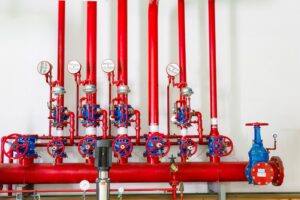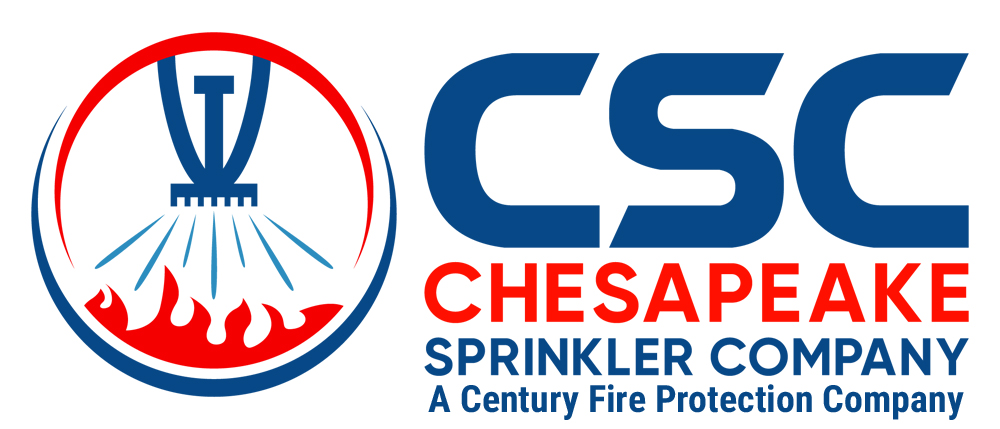
Learn more about standpipe systems.
A standpipe system has been critical in protecting multistory buildings from fires for centuries. For that reason, Maryland business or property owners/managers must have a flow test of their entire standpipe system completed at least every five years. Standpipe systems also have various components, such as gauges and valves, with different inspection requirements. For example, testing gauges on preaction, dry, and deluge valves is essential to ensure adequate air and water level pressures. What is a standpipe system? We’re glad you asked, and here is what you should know.
Standpipe and Hosing Systems Defined
A standpipe is a rigid, pre-piped water system built into multistory buildings vertically so that fire hoses connect to this system, allowing building occupants or firefighters to use water to extinguish a fire. Standpipes provide water for hose lines strategically placed in a building. This water system serves the same purpose as a fire hydrant but extends the fire hydrant system.
Some older buildings solely have standpipe systems, while newer buildings have systems that supply the fire sprinkler and standpipe system. This system is commonly present in large floor area buildings, where a facility might be far away from an outside entrance or in a multistory building to prevent someone from needing to drag a hose for a long distance up a stairwell and on the ground.
Advantages of Standpipe Systems
Once more, standpipe systems prevent a building occupant or firefighter from needing to lay a firehose up a stairwell. You save time when you have fixed outlets in place. Plus, heavy wet hoses tend to slide down when placed on an incline. However, standpipes don’t move. Standpipes keep stairwells clear and make it safer for occupants to evacuate.
Additionally, standpipes reduce the loss of water pressure and friction loss because they don’t loop around the stairwell. Instead, they go directly in an upward and downward position. Once more, it’s a “rigid” system that doesn’t kink or curl, which can happen if a firehose isn’t laid the right way on a stairwell. Standpipe systems also have a level of “redundancy” or the ability to replicate the central distribution water system if it should fail or otherwise become compromised by a fire or explosion.
Two Types of Standpipe Systems
Like a fire sprinkler system has different types, so does a standpipe system, which is wet and dry standpipes. A dry standpipe is a fixed pipe placed with an intake by a road or driveway so that a fire engine can add water to the system. Only firefighters can use dry pipes, whereas building occupants can use wet standpipes. Wet standpipes come with hoses. On the other hand, a wet standpipe has always pressurized water and typically comes with hoses ensuring that building occupants can fight fires expeditiously. Wet standpipes are also installed horizontally on bridges.
What are the Inspection and Maintenance/ Testing Requirements of a Standpipe System?
Once more, a standpipe system is a water system consisting of multiple components. Here is a quick overview of those components and how often they need an inspection.
Inspection and Maintenance
The NFPA requires that standpipe systems have regular inspections and maintenance to ensure the following:
- The system doesn’t have damages or leaks
- Control handles are secure
- The equipment is easily accessible and labeled properly
- The hoses and caps haven’t disintegrated.
- All valves and hose connections are well-lubricated and operable safely and effectively.
- All hoses are removed and reloaded to change the orientation of the folds.
Additionally, all valves need weekly inspections besides supervised or valves secured with locks. Otherwise, a monthly assessment is a requirement. Automatic standpipes also require a monthly evaluation. However, gauges on preaction, dry, and deluge valves need weekly inspections to test for sufficient air and water pressure levels. In contrast, annual reviews include all standpipe pressure-regulating devices, hoses, hose connections, nozzles, hose storage devices, hose cabinets, and all piping.
Testing
The NFPA mandates that standpipe systems undergo regular testing to ensure safe operation, which goes as follows:
- Supervisory signal, valve supervisory, and alarm devices undergo semi-annual tests.
- Hose nozzles, hose storage devices, and the main drain require an annual evaluation.
- A pressure test, backflow, control and pressure-reducing valves, full system flow, and dry pipe hydrostatic test needs to happen every five years.
By now, you might feel as if maintaining your standpipe system is exhaustive. For that reason, it’s the job of a certified fire protection company to handle all your maintenance, testing, and inspections. Chesapeake Sprinkler is that company. Understanding particular systems can be challenging. However, what isn’t complicated is that you need compliant and high-quality fire protection systems to keep yourself, your occupants, your building, and your assets safe.
Contact Chesapeake Sprinkler Company Today!
Chesapeake Sprinkler Company is a leading fire sprinkler contractor in the region, which is now a 100% employee-owned (ESOP) company. As a full-service fire protection company, we offer design, fabrication, installation, testing, maintenance, and inspection of fire protection systems—everything you need from your fire suppression specialist.
For more information, please email or call our Odenton location at 410-674-7041, our Ashburn location at 703-729-5150, or for service/maintenance Chesapeake Protection Services at 410-674-7577. Feel free to keep in touch through Facebook, Twitter, or LinkedIn!
